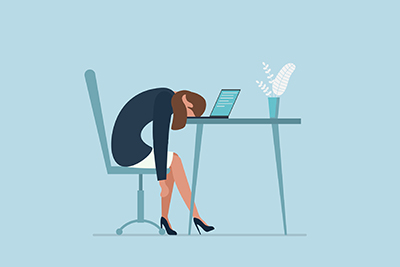Among the many legacies of COVID-19 will be the test of our endurance for spending time in front of screens. Remote workers are spending 29% more time in team meetings and 24% more time in one-on-one meetings than they were before the pandemic, according to a study from the calendar-assistant company Clockwise.

The phrase “video fatigue” (aka “Zoom fatigue”) has entered the lexicon to capture the emotional exhaustion, anxiousness, and worry that accompany many of these virtual meetings.
How Zoom Fatigue Impacts Workers
Understanding the physical and psychological factors behind video fatigue is the first step in reducing its emotional toll. New data from the Society for Human Resource Management (SHRM) indicate that 41% of employees working at home during the pandemic feel burnt out, drained, or exhausted from their work, so addressing video fatigue—an obvious contributor—could go far in buffering workers from the full force of rapidly changing habits and norms.
Researchers cite several aspects of videoconferencing that cause fatigue by disrupting the fine-tuned, instinctual ways of communicating that evolved to help us survive. For example, the absence of nonverbal cues, such as hand gestures and other body language, requires sustained and intense attention to words.
Additionally, constantly staring at our image on the screen creates self-consciousness and increases the pressure to perform, requiring more energy than a simple interaction. The natural tendency to look into the eyes of the people with whom we are speaking is also disrupted due to the disparity between the position of the camera and the position of the eyes on the screen. As a result, we feel uneasy because it’s hard to read people’s responses and shift our own behavior accordingly.
Finally, when we are already staring at a screen, it may be difficult to resist e-mailing, chatting, or finishing up our latest PowerPoint® presentation—even though such multitasking puts more demand on our brains. In the worst case, the higher potential for multitasking during virtual meetings combined with asynchronous eye gaze creates a dissonance that can chip away at trust.
Such feelings may be magnified by technical glitches—lags and freeze-ups—that underscore the fragility of connection, as well as the sudden loss of the people and boundaries we had before.
New Data to Reveal Key Insights
How can HR professionals help recognize and alleviate some of these difficult feelings? Translational research on the transition to working from home after COVID-19 may give us definitive answers and guidance for the future. Results of a study led by Kristen Shockley will be published soon.
In the study, people who worked no more than 10% of the time at home before the pandemic versus at least 32 hours per week after the lockdown were surveyed over 4 weeks to discern their day-to-day experiences with remote work.
Preliminary findings suggest the average frequency of video meetings attended per week affected respondents’ overall experience of remote work. Higher average numbers of hours spent in virtual meetings per week correlated with markers of general stress and impaired performance, as well as a lower preference for working remotely in the future.
Leaders, meanwhile, know from experience that without the need to be present in various locations, the volume of videoconferences can snowball. Already stressful meetings may become amplified and so, too, the weight of decision-making. For people uncertain about job stability, videoconferencing may increase the sense of urgency to be “always on” and responsive, leading to further depletion.
Here’s How HR Can Help
The good news is that video fatigue is a solvable problem when organizations educate employees about solutions to common triggers. Here are some practical strategies:
Triage meetings away. It’s easier said than done, but if you are reaching the point of fatigue, ask yourself which meetings are not absolutely necessary. If you still need to attend, consider shifting to audio only.
Shift the camera. Positioning your camera off to the side instead of straight ahead could help you feel less self-conscious and distracted, particularly in group meetings.
Schedule in short breaks. Shortening meetings by 10 minutes allows time for breaks to recharge. If possible, go outside for a brisk walk. During long calls, take short visual breaks by occasionally looking away from the computer or minimizing the video window.
Create a tight agenda, and stick to it. Organizing an agenda in the format of a set of questions to be answered helps to identify essential attendees, maintain focus throughout a meeting, and evaluate whether goals have been met.
Setting guidelines, such as having everyone put away his or her phone, minimize browsers, and shut down e-mail programs, can prevent multitasking and improve etiquette overall. Participants should mute their microphones unless speaking.
Relax the environment. Be flexible about who needs to have their camera on, and encourage people to be aware of when being on video works or doesn’t work for them. That said, life happens. Unguarded moments—e.g., children or pets wandering by—can serve as reminders that we’re all in the same boat and, by doing so, strengthen team connection.
As the uncertainties of COVID-19 persist, the question of how to use video to foster a sense of togetherness without mental exhaustion is receiving long-overdue attention. HR professionals will be invaluable in shaping this priority issue so that we not only get through this adversity but also emerge from it with new approaches for the future.

Daron Robertson is the cofounder and CEO of Bhive, an innovative virtual technology platform that recreates an open office environment while addressing the common remote challenge of connectivity, accountability, and security. To learn more, please visit https://www.go.inbhive.com/.

Kristen Shockley, PhD, is an editor for the Journal of Applied Psychology and Journal of Business and Psychologyand is currently an Associate Professor of Psychology at the University of Georgia, where she teaches courses on Psychology of the Workplace, Motivation and Engagement, and Work-Family Balance. She has over 50 peer-reviewed publications, book chapters, and edited books. She recently received a National Science Foundation Rapid Response grant to study remote work during COVID-19.
